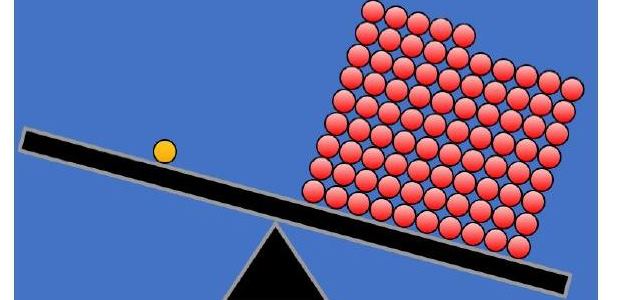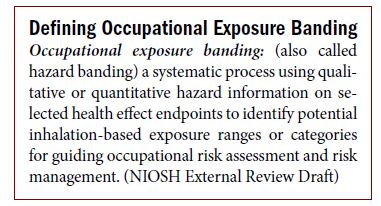
A Framework for Hazard Banding
Exposure limits are absent for thousands of chemicals, creating a need for guidance that occupational exposure banding can help to fill, according to the authors of a new guidance document.
- By Jerry Laws
- May 01, 2017
NIOSH scheduled a public meeting in Cincinnati this month to discuss and hear from industrial hygiene stakeholders about a March 2017 draft Current Intelligence Bulletin titled "The Occupational Exposure Banding Process: Guidance for the Evaluation of Chemical Hazards." Weighing in at 141 pages, it explains the process as one seeking "to create a consistent and documented process to characterize chemical hazards so timely and well-informed risk management decisions can be made for chemicals lacking OELs [occupational exposure limits]."
The meeting is scheduled to begin at 9 a.m. on May 23 at NIOSH's Robert A. Taft Laboratories and will be available via a live webcast. Comments about the guidance document may be submitted until June 13 via www.regulations.gov. (search for CDC-2017-0028 and Docket No. NIOSH-290).
The executive summary portion of the document explains that, according to EPA, the Toxic Substances Control Act Chemical Substance Inventory contains more than 85,000 chemicals that are commercially available, yet only about 1,000 of them have been assigned an authoritative (government, consensus, or peer reviewed) OEL.
"Furthermore, the rate at which new chemicals are being introduced into commerce significantly outpaces OEL development, creating a need for guidance on thousands of chemicals that lack reliable exposure limits," it says.
Guidance for thousands of chemicals that lack OELs is needed, and the occupational exposure banding process is useful because it employs chemical toxicity data to assign a range of concentrations to which chemical exposures should be controlled, with the resulting ranges defining the exposures that are expected to protect workers' health, it states.
The executive summary lists several pros and cons to the OEB process. It can identify potential health effects, target organs, and health risks, inform decisions on control measures and medical surveillance, and provide critical information quickly, and a major benefit is that the OEB process requires far less time and data than what is needed to develop an OEL, it states, but there is greater uncertainty as to whether the OEB is as protective as an OEL produced by a rigorous risk assessment process. An OEB isn't intended to replace an occupational exposure limit, and rather is a starting point to inform risk management decisions, it says.

Three-Tiered Assessment Process
The guidance document explains that, as it is currently practiced, hazard banding requires significant technical expertise in industrial hygiene. And so, to address that limitation, the NIOSH process provides a three-tiered assessment process that allows the technique to be applied with traditional occupational hygiene expertise, as well as the option of more in-depth processes done in consultation with specialists in occupational medicine and toxicology. The three tiers in the process are described this way:
Tier 1: "Qualitative OEB assignment based on GHS. Tier 1 involves assigning the OEB based on criteria aligned with specific GHS hazard codes and categories. It is intended for individuals with basic toxicology knowledge. Chemicals with potential for irreversible health effects at relatively low doses warrant assigning band D or band E. Chemicals that are likely to cause reversible health effects are categorized in band C. Bands A and B are not assigned in Tier 1. Since there are relatively low data requirements for Tier 1, there is not enough information to suggest exposure ranges for chemicals Bands A and B in Tier 1. In general, Tier 1 can be used as a quick screening method, but NIOSH recommends going to Tier 2 if the user expertise and data are available."
Tier 2: "Semi-quantitative OEB assignment based on secondary sources: Tier 2 involves assigning the OEB on the basis of key findings from prescribed literature sources, including use of data from specific types of studies. It is intended for individuals with intermediate toxicology knowledge. Tier 2 is more quantitative in nature than Tier 1. Individuals performing Tier 2 assessments will need to determine a point of departure by using the instructions that are provided for endpoints to support assigning chemicals into bands A, B, C, D, or E."
Tier 3: "Expert Judgement: OEB based on primary sources and expert judgement: Tier 3 involves the use of expert judgement to assign the OEB based on in-depth review of health effects studies. It should only be performed by individuals with advanced toxicology knowledge. Tier 3 involves a more quantitative comprehensive evaluation of the scientific information and requires integration of all available data to determine the band assignment."
Distinguishing the OEB Process from Control Banding
The process guides users to identify an exposure band from among five categories—bands A to E—of increasing severity to health, where band A is the least severe and band E the most severe.
The document distinguishes the occupational exposure band process from the concept of control banding, saying the OEBs process uses only hazard-based data such as studies on human health effects or toxicology studies to identify an overall level of hazard potential and an associated airborne concentration range for chemicals with similar hazard profiles. Control banding, however, essentially links hazards to specific control measures, it explains.
The authors of the document—the acknowledgements page credits seven principal authors and 35 others who provided comments, feedback, internal peer review, etc., and says the guidance document was written by a multidisciplinary team from the NIOSH Education and Information Division—note that the alignment between the exposure bands and current OELs was evaluated in order to build confidence in the occupational exposure banding approach. Analysis of a UK hazard banding scheme found that for 98 percent of the banded chemicals, the target exposure for hazard banding was lower than the OEL. Similarly, NIOSH compared the Tier 1 and Tier 2 banding results for 600 chemicals for which OELs currently exist and found that the overall of Tier 1 bands that were at least as protective as the OEL was 91.5 percent, they reported.
NIOSH's meeting notice asked stakeholders to place special emphasis on technical review of 11 questions, including these:
- If a chemical can cause an immediate effect (necrosis, sensitization, pulmonary edema, central nervous system (CNS) effects), should there be special guidelines for assigning a short term OEB or emphasizing the importance of keeping even short duration exposures below the OEB for those types of toxicants?
- If a skin toxicant is a corrosive, irritant, or sensitizer, should there be any special designation assigned along with the occupational exposure band (OEB)? Additionally, please comment on the utility of using skin and eye effects to create inhalation based bands.
- The comparison of Tier 1 and Tier 2 results for a set of chemicals showed that Tier 1 and Tier 2 produce the same band for 65% of the chemicals tested. Tier 1 is more protective for 17.5% of the chemicals, while Tier 2 is more protective for 17.5% of the chemicals. NIOSH currently recommends that both the tier 1 and tier 2 process be completed for a particular chemical. Do you agree with this recommendation? If not, what approach should NIOSH take?
- NIOSH has proposed a number of sources of information for the different human health and toxicological endpoints under consideration. Are there other sources of information that should be recommended? Are there some sources that should be omitted?
- How should NIOSH consider data collected on structural analogs or related chemicals in the banding scheme?
- If a chemical has two forms (vapor or particulate) in the workplace, we have recommended that the most protective OEB take precedence. Please comment on the utility and adequacy of that recommendation.
- Acute toxicity information may be presented in an array of different units. We have attempted to address those possibilities in the banding criteria for the acute toxicity endpoint, especially for inhalation exposures. Is this information sufficiently clear? Are suitable rubrics for unit conversions provided?
- Does this draft document adequately describe the occupational exposure banding process in a way that supports its use in assigning ranges of exposure concentrations to protect worker health in the occupational setting?
References
1. https://www.federalregister.gov/documents/2017/03/15/2017-05115/draft-current-intelligence-bulletin-the-occupational-exposure-banding-process-guidance-for-the
This article originally appeared in the May 2017 issue of Occupational Health & Safety.